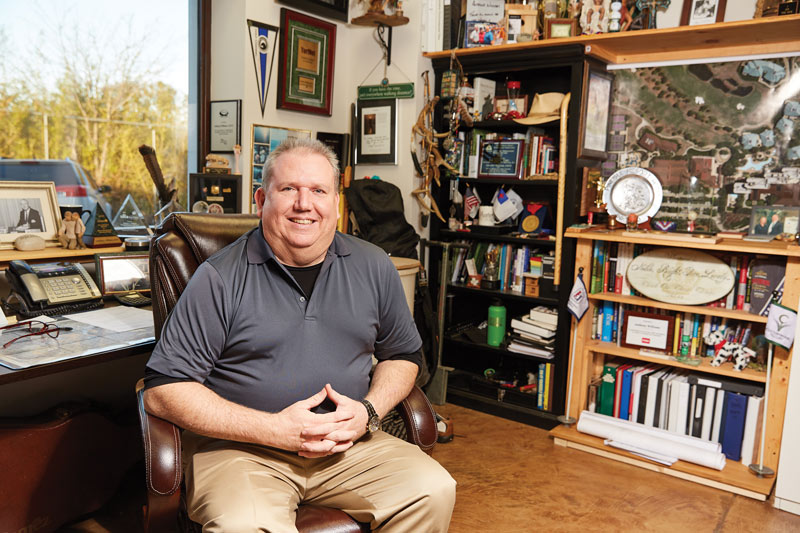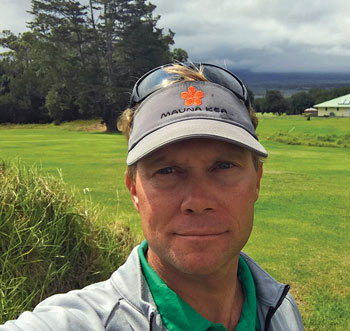
Anthony Williams, CGCS (third from left) and the rest of the maintenance team at TPC Four Seasons Golf and Sports Club in Irving, Texas, have plenty to celebrate as winners of the 2017 Overall and National Private ELGA. The senior leadership team includes (from left to right) Jacob Boelsche, assistant superintendent; Landon Lindsay, senior assistant superintendent; Williams; Brian Watson, landscape manager; Cortland Winkle, superintendent; Mitch O’Brey, assistant superintendent; and Greg Neill, equipment manager. Photo by Jason Kindig
Anthony Williams, CGCS, has always been one to celebrate accomplishments. And throughout his nearly four decades in golf course management, there have been plenty to celebrate.
That’s one of the reasons his offices have always been part workspace, part trophy case. When you’re honored in the way the 21-year GCSAA member has been over the years — from recognition in the environmental and advocacy arenas to leadership accolades — you have to put the awards somewhere.
The sheer scope of those displays has been the subject of good-natured joking among Williams’ friends and colleagues. “When I won the Distinguished Service Award from the Georgia GCSA (in 2016), there was a little underground video that went up, kind of a spoof of the ‘Undercover Boss’ TV show, where I had an employee whose only job was to dust all the plaques and awards in my office on a daily basis,” Williams says.
That gentle ribbing has always been accompanied by equal measures of admiration and respect, not only for what Williams and his teams have achieved, but, more importantly, for the dedication and commitment to the industry that those honors represent. As Williams will tell you, filling his office with awards was never the goal; instead, they were just the happy byproduct of doing the right things, and of getting involved and of giving back to the industry. “Over the years, I’ve tried to learn the difference between good seeds and bad seeds, and just tried to sow as many good seeds as I can,” Williams says. “When you keep sowing the good seeds, you’re going to get a better harvest.”
It’s a philosophy that continues to bear fruit for Williams at the latest stop on his career journey, the TPC Four Seasons Golf and Sports Club Dallas at Las Colinas in Irving, Texas. A little more than a year ago, he and his trophy case headed west to take over as the director of golf operations and landscapes at the venerable 36-hole facility, a post he assumed with two top goals in mind: successfully hosting the PGA Tour’s AT&T Byron Nelson, and implementing his particular brand of “environomics” at a facility that had already accomplished much in the environmental space.
Mission accomplished. In May, the facility hosted its 35th and final Byron Nelson (the tournament is moving across town to Trinity Forest this year) with few visible hitches. And as 2017 wound to a close, Williams received confirmation that his sustainability practices had gained full traction in the Lone Star State when he and TPC Four Seasons Golf and Sports Club were selected as the Overall and National Private winners of the 2017 Environmental Leaders in Golf Awards (ELGA), presented by GCSAA and Golf Digest in partnership with Syngenta.
In addition to adding one more plaque to his already-crowded wall of fame, this year’s ELGA recognition also makes Williams the contest’s first “triple crown” winner — a national winner in the program’s private, public and resort categories. He previously won the National Resort award in 2005 when he was at Renaissance Pine Isle Resort and Golf Club in Sugar Hill, Ga., and the Overall and National Public honor in 2006 at Stone Mountain (Ga.) Golf Club.
“Coming here after basically a year off and knowing the reputation of this property and of golf in North Texas, I was really excited to see how we were going to measure up,” says Williams, who won GCSAA’s President’s Award for Environmental Stewardship in 2010. “The good news is that we measured up really well, and that’s a credit to the staff here and how they bought into what we were trying to do.”
A terrific trio earns 2017 Environmental Leaders in Golf Awards
The ELGA celebrations for 2017 aren’t limited to Williams and his team at TPC Four Seasons Golf and Sports Club. Two other superintendents are sharing the national spotlight with Williams, while 15 chapter and four merit winners also earned recognition in the competition.
Taking home the National Public honor was Jay Neunsinger, the GCSAA Class A superintendent at Boundary Oak Golf Course in Walnut Creek, Calif., and a 16-year member of the association. The National Resort award went to 24-year GCSAA member Scott Main, CGCS, the director of agronomy at Mauna Kea Resort in Kohala Coast, Hawaii.
The ELGAs recognize golf course superintendents and their courses for overall course management excellence and best management practices in the areas of water conservation, water quality management, energy conservation, pollution prevention, waste management, wildlife and habitat conservation, communication and outreach, and leadership. This year’s winners will be formally recognized Tuesday, Feb. 6, during the GCSAA Opening Night Celebration at the 2018 Golf Industry Show in San Antonio.
Been there, done that
That Williams was able to push TPC Four Seasons Golf and Sports Club into the national environmental spotlight just one year into his tenure is a remarkable feat, no doubt. But he says he had two key advantages in making that happen.
First, he’d done it before. His Overall and National Public awards in 2006 at Stone Mountain came just a year after he’d taken over operations at that Marriott property. And second, he inherited a facility and a maintenance team in Texas that were already doing a lot of the right things when it came to sustainable practices.

With his selection as the Overall and National Private winner this year, Williams becomes the first superintendent to achieve the ELGA “triple crown,” earning national wins in the program’s private, public and resort categories. Photo by Jason Kindig
“My predecessors here (Scott Abernathy, Ph.D., now the corporate director of agronomy for Omni Resorts, and before him, John Cunningham, CGCS, now the general manager at Aronimink Golf Club in Newton Square, Pa.) had done great work. The core programs were in place,” Williams says. “That allowed me to come in and expand on what was already working, and focus on things that have been my trademarks — nest boxes, feeders, supplemental habitats, thinks like that.”
It also let him focus on fully implementing his signature environomics, which is simply a strategy of connecting sustainability efforts on the golf course directly to the facility’s bottom line. As Williams described it in his ELGA application, “We integrate our environmental plan into our financial plan, enabling us to create a world-class golf experience within our urban green space that is sustainable environmentally and financially. In 2017, our programs saved $98,389.73.”
The examples of the connection between sustainability and economics are easy to spot throughout the operations at TPC Four Seasons Golf and Sports Club. Through a series of water conservation efforts — including pump station upgrades and an emphasis on hand-watering and scouting — Williams estimates the facility saved $34,000 in water costs last year. An intense integrated pest management program — centered around an “IPM war room” complete with microscopes, diagnostic tools, and information on the property’s IPM history — shed more than $28,000 from the club’s chemical/fertilizer expenses. A new turf care facility that opened in 2016 with all the latest energy-saving bells and whistles saved another $14,000. Even recycling efforts around the maintenance department have a measurable, bottom-line impact (those saved $3,338 in 2017).
‘Many voices, one song’ at TPC Four Seasons Golf
Putting TPC Four Season Golf and Sports Club in a position to win the Overall ELGA in Williams’ first year on the job was a tall task, he readily admits. Doing all that while also preparing to host a PGA Tour event of the stature of the Byron Nelson? Well, that was something else altogether.
That’s why Williams preaches the value of teamwork, of involving every member of the maintenance staff — from his assistants down to a part-time laborer — in sustainability endeavors, so that each can speak as eloquently as he does about what they’re doing and why they’re doing it.
“The only way I could see all of this happening in my first year here was to have everybody ... fully able and ready to contribute,” Williams says. “I tried to just conduct the orchestra, make sure people were in the right place at the right time, and just encourage their growth. The whole team deserves the credit for what we were able to accomplish in hosting the tournament and in winning this award.”

Williams says winning the Overall and National Private ELGAs and hosting a PGA Tour event in his first year on the job at TPC Four Seasons Golf and Sports Club was the ultimate team effort. “The only way I could see all of this happening in my first year here was to have everybody ... fully able and ready to contribute,” he says. Photo by Jason Kindig
And they don’t keep those accomplishments a secret. As mentioned, Williams believes in celebrating successes, both internally and externally. Inside the walls of the maintenance department, that often means recognizing outstanding environmental efforts and innovation at regularly scheduled meetings or through the presentation of special staff awards — the “Golden Hose,” for example, goes annually to the team member who is the best manager of water assets.
Golfers and members get a guided tour of the facility’s sustainability efforts while they’re chasing that little white ball around the golf course, thanks to signage that identifies wildlife habitat and pollinator gardens, and that explains how the course is irrigated and the sources of that water. Williams and team also have an open-door policy for those who may have questions about golf course management practices or just want to poke around the trophy case that is Williams’ office.
And Williams never shies away from a chance to take his message outside the golf course, to school groups, civic organizations and homeowners associations curious about golf course management and how it coexists with the natural world. He makes more than 25 such presentations annually.
“Our motto is, ‘Many voices, one song,’” Williams wrote in his ELGA application. “We are tireless ambassadors for stewardship, our green space and the game of golf.”

Jay Neunsinger, a 16-year GCSAA member, has led maintenance efforts at Boundary Oak Golf Course in Walnut Creek, Calif., for three years. Photo courtesy of Jay Neunsinger
Jay Neunsinger
Boundary Oak Golf Course
Walnut Creek, Calif.
National Public winner
Among golf enthusiasts in the San Francisco Bay Area, Boundary Oak Golf Course in Contra Costa County, east of San Francisco proper, is well known as one of the region’s most popular tracks, attracting more than 67,000 rounds annually.
What may not be as well known among the players drawn to Boundary Oak’s setting amid the foothills of the Diablo Mountain Range is the facility’s standing as one of golf’s true environmental success stories, a reputation reinforced this year by Neunsinger’s selection as the 2017 ELGA National Public winner.
“Like most superintendents, I believe that we are stewards of the land,” Neunsinger wrote in his ELGA application. “Every decision we make has the environment as the first factor that we look at and consider.”
A study of Neunsinger’s accomplishments at Boundary Oak proves that he not only talks the talk, but walks the walk. Take water conservation, for example. When he arrived at the facility three years ago, the region was entering its third consecutive year of extreme drought, conditions that were taking their toll on the course’s playing surfaces as well as on the water resources that Boundary Oak counts on for its survival.
So, among his first tasks on the job was the creation of a drought management plan for the club, one that could help keep grass alive even when Boundary Oak’s usual water supplies were taxed. Among a host of other moves, he brought in an outside irrigation consultant to evaluate the course’s existing system, leaned heavily on staff training to break old habits and create better new ones, and increased his reliance on tools such as his on-site weather station, wetting agents and hand-held moisture meters.
The results? In his three years at Boundary Oak, the course has reduced its water use by more than 25 percent, from 113 million gallons in 2013 to 85 million in 2016.

Boundary Oak Golf Course in Walnut Creek, Calif., is one of the Bay Area’s most popular public courses, attracting more than 67,000 rounds annually. Photo courtesy of Jay Neunsinger
The achievements don’t end there. Neunsinger inherited a comprehensive, site-specific IPM plan with property-wide thresholds for pests, and since 2010, Boundary Oak has reduced insecticide applications by 17 percent. In 2017, the course completed installation of more than 1,000 solar panels that now generate enough electricity to cover half of the facility’s needs. A property-wide recycling effort — inspired by Boundary Oak’s participation in a REV Sustainability Circle in 2014, a learning program that allows businesses to improve their environmental performance by sharing best practices with other like-minded organizations — has resulted in a 38 percent reduction in the facility’s landfill input over the past two years.
Boundary Oak’s wildlife habitat efforts have also made headlines. The course has been a certified Audubon International Wildlife Sanctuary since 2012. Since his arrival, Neunsinger has worked closely with a local bluebird recovery program, and there are 26 bluebird boxes on the property, which has helped Boundary Oak increase its fledged bird count from 211 in 2010 to 441 in 2017.
Among Neunsinger’s most notable accomplishments has been his involvement in beekeeping. A member of the Mount Diablo Beekeepers Society, Neunsinger and his team created a high-fenced bee apiary that houses four beehives and is surrounded by pollinator-friendly plants. Educational signage is prominently placed near the apiary to inform golfers of the facility’s efforts, and Neunsinger has partnered with the First Tee of Contra Costa to showcase ways golf can benefit pollinators through a series of presentations and educational sessions for young, up-and-coming golfers.

Scott Main, CGCS
Mauna Kea Resort
Kohala Coast, Hawaii
National Resort winner
“Firsts” are nothing new at Mauna Kea Resort, located on the northwestern shore of the island of Hawaii. The resort was the Big Island’s first when it opened its doors in 1965, the brainchild of businessman and noted conservationist Laurance S. Rockefeller, who insisted the development blend seamlessly with the area’s natural beauty while honoring the island’s traditions. The golf course affiliated with the resort — designed by Robert Trent Jones Sr. and opened a year before the resort — was also a first for the Big Island. And like the resort, its design and construction were done with a sincere nod toward the environment and the history of the islands.
Now, Main has secured another first for Mauna Kea. His recognition as the winner of the National Resort award in the 2017 ELGA competition marks the first time that a Hawaiian facility has earned national recognition. A quick review of exactly how Main and his team go about managing this oceanfront property confirms that the groundbreaking honor is well-deserved.
Mauna Kea has been a willing partner with a host of outside organizations and government agencies in their efforts to solidify the golf course’s standing as an environmental leader and a good neighbor. In partnership with the National Park Service, they help maintain a portion of the Ala Kahakai National Historic Trail, a 175-mile trail network with great cultural and natural significance on the Big Island.

Mauna Kea Resort on Hawaii’s Big Island is a Robert Trent Jones Sr. design that opened for play in 1965. It was designed and constructed with a constant focus on environmental impacts and blending the course with the island’s natural beauty. Photo courtesy of Scott Main
They’ve worked with Hawaii’s Department of Land and Natural Resources on a number of projects — one designed to protect nesting areas for the state’s official bird, the nene goose (aka the Hawaiian goose), which has helped increase its on-site population by 300 percent in the past three years, and another that helped establish four thriving honey bee hives on the course, which produce honey used by the resort’s restaurants. They’ve even partnered with the Marine Science Department at the University of Hawaii, Hilo on an ongoing study examining the potential impact of sewage and nitrogen levels on coastal reefs (results confirmed the golf course was not a source of pollution affecting those reefs).
In addition to these outside partnerships, Main is making sure that he and his team keep their own house in order at Mauna Kea. An effort is underway to convert the bulk of the facility’s playing surfaces from bermudagrass to seashore paspalum (the current ratio is close to 60-40), largely in an effort to conserve water and reduce inputs. And Mauna Kea recently shifted its equipment fleet to John Deere hybrids to save fuel, a move that has reduced fuel consumption from 5 gallons per day per piece of equipment to 5 gallons per week.
Despite the obvious accomplishments at Mauna Kea, Main wasn’t about to let others simply take his word for the facility’s dedication to environmental practices. So, he agreed to participate in a third-party sustainability assessment, which measured strengths and weaknesses in the areas of conservation, energy use, pollution, waste management and biodiversity. As you may expect from a National Resort ELGA winner, Main and Mauna Kea came through with flying colors, and the study has been shared with resort guests, the media and local government officials. It will also be a key part of the Hawaii GCSA’s advocacy message at the 2018 State Golf Day event in Honolulu.
More ELGA honorees
In addition to the three national winners of the Environmental Leaders in Golf Awards, there were 15 chapter winners and four merit winners selected from GCSAA’s 99 affiliated chapters.
Chapter winners
Stephen Britton, CGCS
TPC Potomac at Avenel Farm
Potomac, Md.
Mid-Atlantic Association of GCS
Mark Condos
Las Positas Golf Course
Livermore, Calif.
GCSA of Northern California
Matthew Gourlay, CGCS
Colbert Hills Golf Course
Manhattan, Kan.
Heart of America GCSA
Gary L. Heath
Glendoveer Golf & Tennis
Portland, Ore.
Oregon GCSA
Gary Ingram, CGCS
Metropolitan Golf Links
Oakland, Calif.
California GCSA
Bobby Jaeger
Lake Tahoe Golf Course
South Lake Tahoe, Calif.
Sierra Nevada GCSA
Andrew Jorgensen, CGCS
Candler Hills Golf Club
Ocala, Fla.
Florida GCSA
Mark Krick, CGCS
Fox Hollow and Homestead Golf Courses
Lakewood, Colo.
Rocky Mountain GCSA
Mark D. Kuhns, CGCS
Baltusrol Golf Club
Springfield, N.J.
New Jersey GCSA
Wayne Mills
La Cumbre Country Club
Santa Barbara, Calif.
GCSA of Southern California
Jim Pavonetti, CGCS
Fairview Country Club
Greenwich, Conn.
Metropolitan GCSA
Charles “Roby” Robertson IV, CGCS
TPC Scottsdale
Scottsdale, Ariz.
Cactus & Pine GCSA
Ian Schlather
TPC River’s Bend
Maineville, Ohio
Greater Cincinnati GCSA
Carl D. Thompson, CGCS
Columbia Point Golf Course
Richland, Wash.
Inland Empire GCSA
Marc Weston, CGCS
Indian Hill Country Club
Newington, Conn.
Connecticut Association of GCS
Merit winners
Michael Bednar
Palouse Ridge Golf Club
Pullman, Wash.
Inland Empire GCSA
Dave Davies, CGCS
TPC Stonebrae
Hayward, Calif.
GCSA of Northern California
Troy Flanagan
The Olympic Club
San Francisco
GCSA of Northern California
Darin Pakkala
Crystal Springs Golf Course
Burlingame, Calif.
California GCSA
Scott Hollister is GCM’s editor-in-chief.